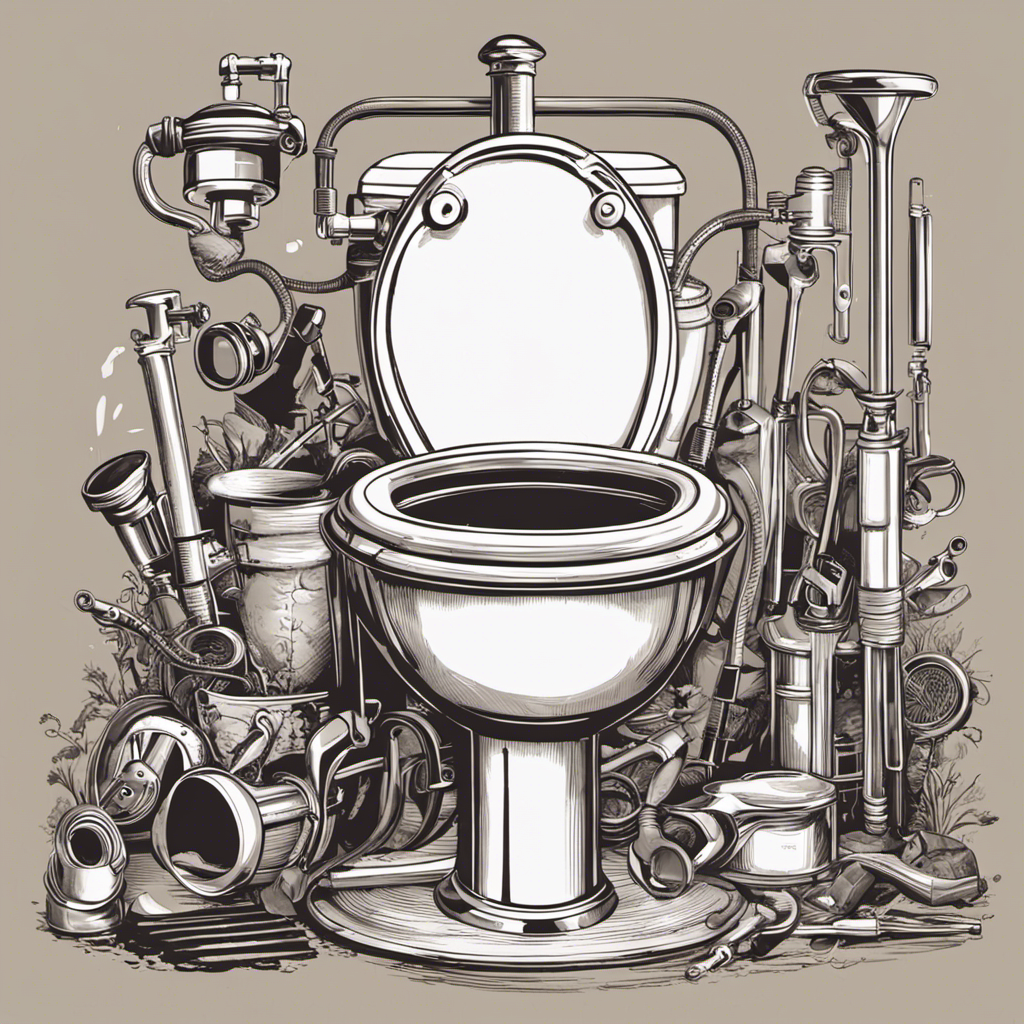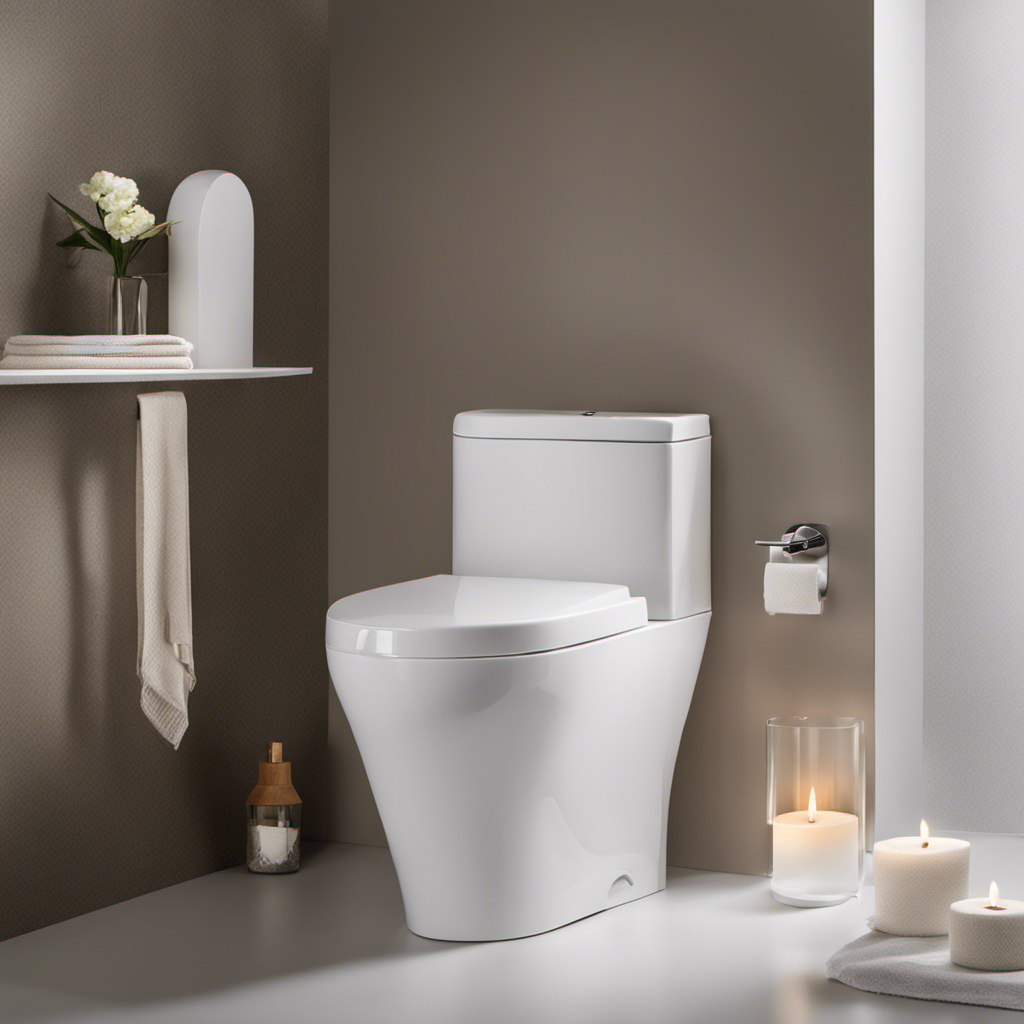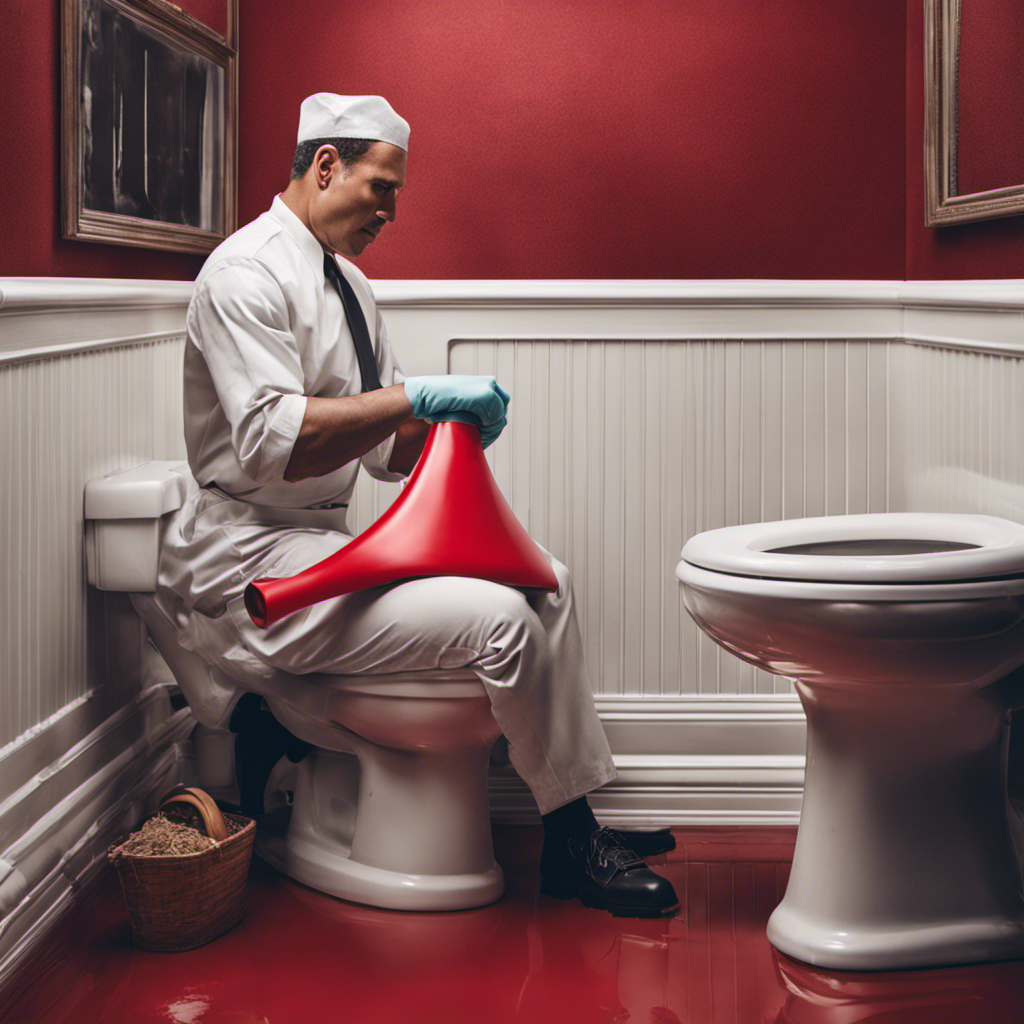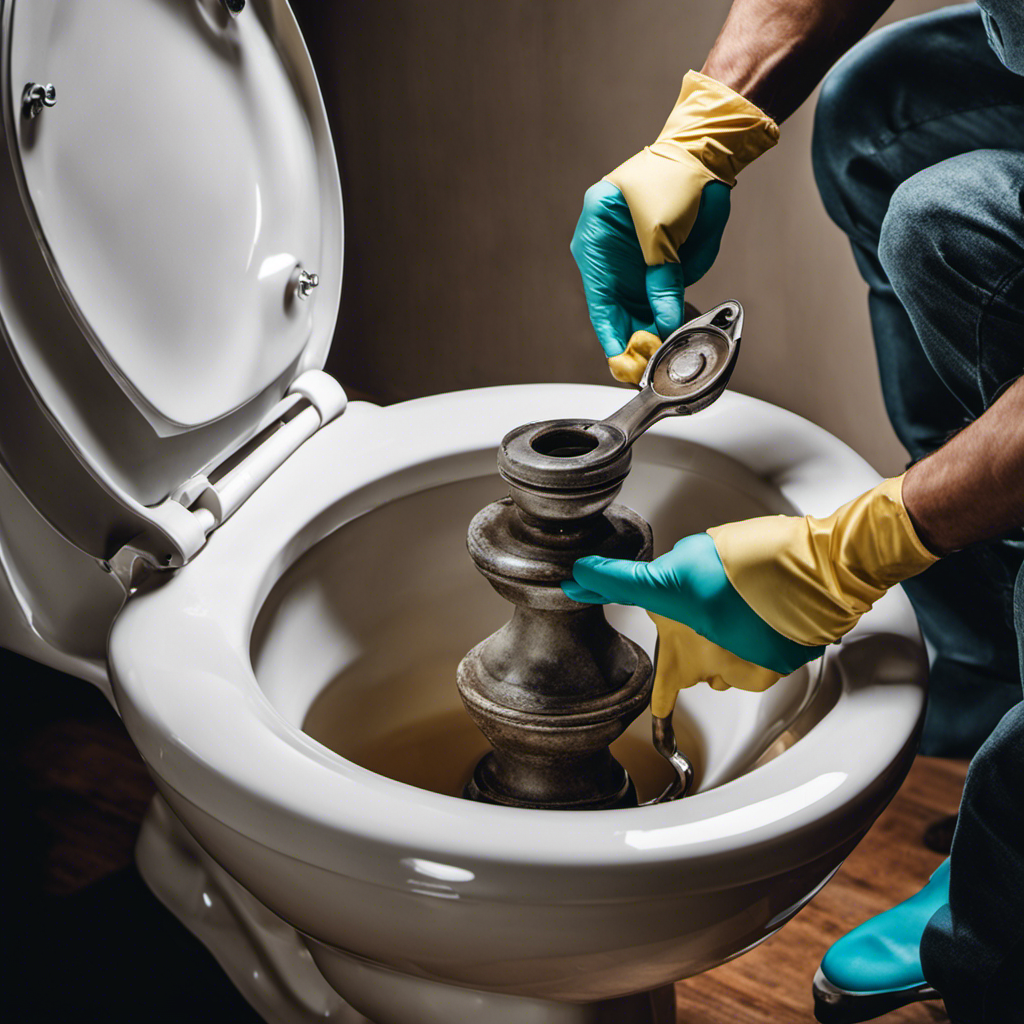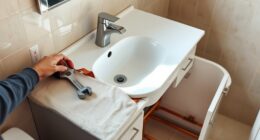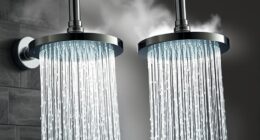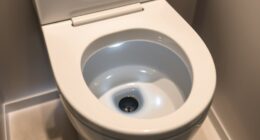As someone who has dealt with the frustrating issue of a toilet backup, I understand the importance of finding effective solutions.
From invasive tree roots to hair buildup and flushed objects, there are various causes that can lead to this problem.
But fear not, because in this article, I will guide you through the causes, fixes, and prevention techniques for toilet backups.
By understanding the root causes and implementing the right solutions, you can ensure a smooth and trouble-free bathroom experience.
So let’s dive in and explore the world of toilet backup solutions together.
Key Takeaways
- Tree roots invading sewer lines and hair buildup in shower drains are common causes of toilet backup.
- Flushed objects that are non-flushable and pipe scale from mineral buildup can also lead to blockages.
- To fix a backup, the main water supply should be shut off if there is flooding, a drain snake can be used to break down stubborn clogs, and obstructions in the vent pipe should be checked and removed.
- Prevention tips include avoiding flushing non-flushable items, regularly cleaning and maintaining the toilet, using easily dissolvable toilet paper, installing drain screens, and scheduling professional drain cleaning regularly.
Root Invasion: Understanding the Causes and Solutions
I can prevent root invasion by avoiding planting trees near sewer lines. This is because tree roots can break through pipes over time, causing blockages and backups in toilets and showers. Root invasion is a common cause of toilet backups and can be a major headache to deal with.
To prevent this, it is important to schedule regular inspections to identify and remove any tree roots that may be causing backups. Trees seek water during dry spells, so their roots are more likely to grow towards sewer lines. Regular inspections can help identify any potential issues and allow for the prompt removal of tree roots before they cause major problems.
Dealing With Hair Buildup: Prevention and Remedies
When dealing with hair buildup in drains, it is important to regularly clean and maintain the shower to prevent clogs. Hair falling out in the shower can easily cause clogs, especially when it combines with other debris.
To prevent this, make sure to clean the drain regularly by removing any visible hair. Additionally, consider using a drain screen to catch hair before it goes down the drain.
If you already have a clogged shower drain due to hair buildup, there are a few remedies you can try. One option is to use a drain snake to break up the clog and remove the hair. Another option is to use a mixture of vinegar and baking soda to dissolve the hair and clear the drain.
Flushed Objects: How to Avoid Blockages and Backups
Using a drain snake or a plunger can help dislodge flushed objects that are causing blockages and backups in the plumbing system. Toilet backups are commonly caused by flushed objects that should not be flushed, such as wipes, feminine hygiene products, and paper towels. These items can get stuck in the pipes and create blockages that prevent proper drainage.
To prevent toilet backups, it is important to only flush water, biodegradable toilet paper, and waste. Regular maintenance, such as scheduling professional drain cleaning and avoiding flushing non-flushable items, can also help prevent blockages.
If you find yourself with a clogged toilet and no plunger, you can try using a drain snake to break up the blockage. Insert the snake into the toilet and rotate it to dislodge the clog. However, if the clog persists or you are uncomfortable tackling the problem yourself, it is best to call a professional plumber for assistance.
Pipe Scale: Causes and Methods for Removal
Regular maintenance and proper water treatment can help prevent the buildup of pipe scale, a common cause of plumbing blockages and backups.
Pipe scale is formed when minerals in the water accumulate over time and create a hard, crusty substance that coats the inside of pipes. This buildup can restrict water flow, leading to clogs and backups in your plumbing system.
To prevent pipe scale, it is important to remove mineral buildup regularly. This can be done by using descaling agents or vinegar to dissolve the scale and flush it out of the pipes.
Additionally, installing water softeners or filters can help prevent the formation of pipe scale by reducing the mineral content in the water.
Grease Accumulation: Prevention and Clearing Techniques
I can prevent grease accumulation in my pipes by properly disposing of oils, fats, and grease from dirty dishes. Grease accumulation is a common cause of blockages in drains and can lead to backups and unpleasant odors.
To prevent grease from building up in my pipes, I should follow these prevention techniques:
-
Avoid pouring grease down the drain: Instead of pouring grease down the sink, I can let it cool and solidify, then scrape it into a container and dispose of it in the trash.
-
Use strainers: Placing strainers over the drains in my kitchen sink can help catch food particles and prevent them from entering the pipes.
-
Regularly clean the drains: By flushing hot water down the drain and using a mixture of baking soda and vinegar, I can help break down any grease buildup in the pipes.
Fixing the Backup: Step-by-Step Solutions
When faced with a toilet backup, my first step is to shut off the main water supply to prevent flooding. This is crucial to avoid further damage and ensure a safe environment.
After that, I assess the situation and determine whether I can fix the backup myself or if I need to call a professional plumber. It’s important to weigh the options between DIY methods and professional plumbing services.
While some backups can be resolved with simple techniques like using a drain snake or clearing obstructions in the vent pipe, there are common mistakes that people often make when attempting to fix the issue themselves. These mistakes include using harsh chemicals, neglecting to check for obstructions in the vent pipe, or not properly clearing blockages further down the pipe.
If the backup persists or affects multiple drains in the house, it’s best to call a professional plumber who has the expertise and tools to thoroughly inspect and repair the problem.
Prevention Is Key: Tips to Avoid Toilet Backup
Installing drain screens and regularly scheduling professional drain cleaning are key preventive measures to avoid issues with the toilet and shower drains.
Here are three common causes of toilet backup and effective prevention methods:
-
Flushing non-flushable items: Avoid flushing anything other than water, biodegradable toilet paper, and waste. Non-flushable items can cause blockages and backups.
-
Tree roots invading sewer lines: Trees seeking water during dry spells can break through pipes over time. To prevent this, consider planting trees away from sewer lines or installing root barriers.
-
Hair buildup in shower drains: Hair falling out in the shower can catch other debris and create clogs. Use drain screens to catch hair and regularly clean them to prevent buildup.
By following these prevention methods, you can avoid the inconvenience and costly repairs associated with toilet backups.
Don’t ignore the signs of a toilet backup, such as water rising in the shower drain, gurgling noises, slow draining, foul odors, or overflowing toilet water. Take action and address the issue promptly to prevent further damage.
Frequently Asked Questions
How Much Does It Cost to Hire a Professional Plumber to Fix a Toilet Backup?
Hiring a professional plumber to fix a toilet backup can vary in cost depending on the severity of the issue and location. DIY fixing offers cost savings, but professional help ensures thorough inspection and repair.
Can Using Harsh Chemicals to Clear a Toilet Backup Cause Damage to the Pipes?
Using harsh chemicals to clear a toilet backup can potentially damage the pipes. It’s important to understand the risks involved and consider alternative prevention methods to avoid further complications and costly repairs.
Are There Any Natural Remedies or DIY Methods to Prevent Toilet Backups?
Yes, there are natural remedies and DIY methods to prevent toilet backups. Some options include using a mixture of baking soda and vinegar, using a plunger, or regularly maintaining your toilet and drains.
How Often Should Drain Cleaning Be Scheduled to Prevent Toilet Backups?
Drain cleaning frequency depends on usage and the presence of toilet backups. Best techniques for preventing backups include avoiding non-flushable items, regular toilet maintenance, dissolvable toilet paper, drain screens, and scheduling professional drain cleaning as needed.
What Are the Signs That Indicate a More Serious Plumbing Issue Beyond a Simple Toilet Backup?
Some signs of a serious plumbing issue beyond a simple toilet backup include persistent backup problems, inability to clear the clog with DIY methods, multiple affected drains, unpleasant sewer smell, and the need for professional inspection and repair.
Conclusion
Well, folks, we’ve reached the end of our journey through the world of toilet backups. I hope you’ve enjoyed this wild ride as much as I have.
From pesky tree roots to hairball horrors, we’ve covered it all.
But fear not! Armed with the knowledge we’ve gained, we can now face these stinky situations head-on. Remember, prevention is the key to a happy toilet, so treat it with love and care.
And if all else fails, don’t be afraid to call in the professionals.
Happy flushing, my friends!
